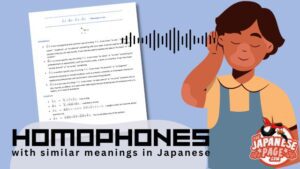Makoto+ Members, click here to download all the sound files and a PDF just for this lesson.
About Japanese Homophones
Homonyms in Japanese is called:
同音異義語
Which if you breakdown the kanji, it makes sense:
- 同音 same sound
- 異義 different meaning
- 語 word
Every language has homophones (same sound, different meaning), but since Japanese has relatively few possible sounds to use when making words, there are a ton of homophones.
I'm sure you've noticed this. You may have also notice that words that sound the same when spoken and appear to have the same meaning use different kanji sometimes when written.
This is more properly called
同音異字
同音異字 can be broken down into three parts: 同音 means "same sound" or "homophonic," 異 means "different," and 字 means "character." Thus, 同音異字 refers to words or characters that have the same pronunciation but different meanings and different written forms.
- 同音 same sound
- 異字 different character
Here’s the Wikipedia article on this, but the list includes a lot of pairs that have very different meanings.
This article will explore a few of these homonym/synonym groupings that sound the same, mean basically the same thing, but use different kanji when written.
I’m also including the standard pitch accent for the words. While I was unable to find pitch accents for all the words, Interestingly, the ones I did find were all the same. So, when spoken, whether you meet a friend (会う) or a bear (遭う) you say it starting with a high pitch.
Let’s get started with a few kanji that are pronounced 「みる」 and basically mean “to see”.
見る・観る・診る・看る |Meaning: to see
Differences:
- 見る is the most general and common way of writing みる. It can mean “to see”, “to look”, “to watch”, “to glance”, or “to observe” something with your eyes. It can be used for any object or situation that you can see visually. It can also be used to express the idea of "to check" or "to confirm."
- 観る is a more specific way of writing みる. It can mean “to watch” or “to view” something for entertainment or appreciation, such as a movie, a play, a sport, or a scenery. It can also mean “to look around” or “to survey” something.
- 診る is another specific way of writing みる. It can mean “to examine” or “to diagnose” someone’s physical or mental condition, such as a doctor, a dentist, or a therapist. Doctors or healthcare professionals will use this term when examining patients.
- 看る is a rare way of writing みる. It can mean “to take care of” or “to nurse” someone who is sick, injured, or elderly. It is used when referring to the act of taking care of someone who is ill, elderly, or in need of assistance.
Examples:
私は犬を見た。
I saw a dog.
私は映画を観た。
I watched a movie.
風邪をひいたので、医者に診てもらった。
I caught a cold, so I had the doctor examine me.
看護師は患者の面倒を看る。
The nurse takes care of the patient.
足・脚 | Meaning: leg; foot
Differences:
- 足 is far more common, while 脚 is more formal or technical.
- 足 can mean both “leg” and “foot”, while 脚 usually means only “leg” (including thigh but not hip).
- 足 can also mean the whole lower limb, while 脚 cannot.
- 脚 can also mean the legs of a table, chair, or other furniture, while 足 cannot.
Examples:
足が痛いです。
I have a pain in my leg/foot. (ambiguous)
脚が痛いです。
I have a pain in my leg. (not foot)
足の指が痛いです。
I have a pain in my toe. (specific)
このテーブルの脚が折れた。
The leg of this table broke. (not 足)
変わる・代わる |Meaning: to change; to exchange
Differences:
- 変わる This word means "to change" in a broad sense and can refer to changes in various aspects like appearance, shape, quality, or condition. It is often used for describing changes in the natural environment, personal preferences, or situations. For example, when the seasons change or when someone's mood changes.
- 代わる This word emphasizes the act of substituting or replacing something, often in the context of people taking turns or replacing someone in a role or position. It can also refer to a change in generations or the passing of time.
Examples:
季節が変わる。
The season changes.
彼が私の代わりに仕事をする。
He will do the work instead of me.
会う・遭う・逢う・遇う |Meaning: to meet
Differences:
- 会う This is the most common verb for "to meet" or "to see (someone)." It generally refers to meeting someone intentionally, such as for an appointment, gathering, or rendezvous. You can use it when talking about meeting friends, colleagues, or family members.
- 遭う This verb means "to encounter" but often implies an unfortunate or negative situation, such as an accident or disaster. It can also be used for encountering people in a negative context, like running into someone you would rather avoid. For example, “I was robbed” or “I encountered a storm”.
- 逢う This verb also means "to meet" but is generally used in more emotional, romantic, or poetic contexts. It implies a sense of longing or deep emotional connection between the people meeting. For example, “I’m looking forward to seeing her” or “I saw my deceased grandfather in a dream”. It's less common in everyday conversation and is often found in literature, songs, or poems.
- 遇う This verb means "to encounter" or "to come across" and is used for more casual or coincidental meetings. It can be used for people, opportunities, or experiences. This verb is less common than 会う but can be used in similar contexts with a more casual or chance-driven tone. For example, “I won the lottery and encountered luck” or “I met a famous actor at a cafe”.
Examples:
友達に会う
to meet (up with) a friend
事故に遭う
to be involved in an accident
恋人に逢う
to meet (up with) a lover
偶然友達に遇う
to bump into a friend by chance
言う・云う |Meaning: to say
Differences:
- 言う This is the more common and standard form of the verb "to say" in modern Japanese. You will typically encounter this kanji in everyday conversations, textbooks, and formal writing. It is considered the standard way of writing the verb.
- 云う This is an older, more archaic form of the verb "to say." While it carries the same meaning as 言う, it is mostly used when quoting others and is less commonly used in contemporary Japanese. You may come across this kanji in classical literature, older texts, or when an author wants to convey a more traditional or antiquated tone.
Examples:
彼はありがとうと言った
He said, "thank you."
彼はありがとうと云った
He said, "thank you" (with a more classical or archaic nuance)
聞く・聴く・訊く |Meaning: to hear; to ask
Differences:
- 聞く This is the most common verb for "to hear" or "to ask." It refers to the act of hearing sounds, music, or people's voices, as well as asking someone for information or an opinion. You can use it when talking about listening to a conversation, song, or asking a question.
- 聴く This verb also means "to listen" but has a more focused, attentive, or active connotation than 聞く. It is often used when referring to carefully listening to music, a lecture, or a speech. It implies a deeper level of concentration and appreciation for what is being heard. It doesn't include the "to ask" meaning.
- 訊く this verb specifically means "to ask" or "to inquire." It is less common than 聞く and is used when you want to emphasize the act of asking questions or seeking information. It is often used in formal situations, interviews, or interrogations. It doesn't include the "to hear" meaning. Not used very often.
Examples:
意見を聞く
to ask for an opinion
音楽を聴く
to listen to music
詳細を訊く
to inquire about the details
町・街 |Meaning: town
Differences:
- 町 (まち or ちょう) is a term that generally refers to a smaller town or a neighborhood within a city. It is often used to describe residential areas, local communities, or districts with a more traditional or rural atmosphere. When used as a suffix in a place name, it is usually read as 「ちょう」
- 街 (まち or がい): This term is more commonly used to describe urban areas, city streets, or downtown districts with a focus on commercial, entertainment, or shopping facilities. It often carries a more modern, bustling, or lively atmosphere. When used as a suffix in a place name, it is typically read as 「がい」.
Examples:
卒業するとすぐに彼は町を出て行った。
As soon as he graduated, he left town.
山田町に住んでいます。
I live in Yamada Town.
神戸は私が一番好きな街です。
Kobe is the city I like the best.
商店街は平日ひっそりしている。
The shopping district is quiet on the weekdays.
飛ぶ・跳ぶ |Meaning: to fly; to jump
Differences:
- 飛ぶ This verb means "to fly" or "to jump" and is more commonly used to describe the movement of birds, airplanes, or other objects in the air. It can also be used to describe a person jumping, especially over a long distance or with a sense of flying through the air.
- 跳ぶ This verb means "to hop" or "to leap" and is used to describe the action of jumping or leaping off the ground, particularly for people or animals. It often implies a more energetic or vigorous movement, such as hopping on one foot or leaping over an obstacle.
Examples:
鳥が空を飛ぶ
A bird flies in the sky.
飛行機が飛ぶ
An airplane flies.
一つ足で跳ぶ
To hop on one foot.
障害物を跳ぶ
To leap over an obstacle.
回答・解答 |Meaning: answer; response
Differences:
- 回答 This term refers to a response or answer to a question, inquiry, or problem. It is commonly used in the context of spoken or written communication, such as answering a question during a conversation, an interview, or a survey. 回答 emphasizes the act of responding or replying to a question or request for information.
- 解答 This term is more focused on providing a solution or answer to a problem or puzzle, particularly in the context of mathematics, quizzes, or tests. 解答 emphasizes the process of figuring out or solving a problem, rather than simply responding to a question.
Examples:
質問に回答する
to answer a question
数学の問題の解答を見つける
to find the solution to a math problem
図る・測る・計る |Meaning: to plan; to measure
Differences:
- 図る This verb means "to plan," "to scheme," or "to attempt." It is often used when talking about making arrangements or devising a plan to achieve a particular goal or outcome.
- 測る This verb means "to measure" or "to gauge" and is typically used when referring to measuring physical dimensions, such as length, width, height, or distance. It can also be used to measure time or other abstract concepts.
- 計る This verb also means "to measure" but is more commonly used for measuring non-physical quantities, such as time, temperature, or speed. It is often used when talking about taking measurements with an instrument or device.
Examples:
自殺を図る
to plan a suicide (not a very pleasant example, but this kanji is often used in this situation)
距離を測る
to measure distance
時間を計る
to measure time
作る・造る・創る |Meaning: to make; to create
Differences:
- 作る This is the most general and common verb for "to make" or "to create." It can be used in a wide range of contexts for both tangible and intangible things, such as making food, crafting objects, producing art, or creating a plan. 作る is versatile and applicable to various situations where something (usually small) is being made or produced.
- 造る This verb also means "to make" or "to create" but is more specific to manufacturing, building, or constructing on a larger scale. It is often used for making physical structures, such as buildings, bridges, or ships, as well as producing goods in factories.
- 創る This verb carries the meaning of "to create" or "to invent" with a focus on originality, innovation, or artistic expression. 創る is used when emphasizing the creative process or the creation of something new, unique, or imaginative, such as a piece of art, a new product, or an original idea.
Examples:
ご飯を作る
to make a meal
船を造る
to build a ship (big)
新しい製品を創る
to create a new product
勧める・薦める |Meaning: to recommend
Differences:
- 勧める This verb is more commonly used to recommend, suggest, or encourage (or influence) someone to do something or to try something out. It is often used in the context of suggesting activities, experiences, or products. 勧める can also be used to invite or persuade someone to join a group or organization.
- 薦める This verb also means "to recommend" or "to suggest" but is often used in a more formal context or when recommending a person for a position, role, or award. 薦める is commonly used when endorsing someone for their skills, abilities, or expertise. To nominate...
Examples:
新しいレストランを勧める
to recommend a new restaurant
候補者として彼を薦める
to recommend him as a candidate
対象・対照 |Meaning: target; comparison
Differences:
- 対象 means "target" or "object" in the sense of something being subject to a particular action, discussion, or focus. It is often used in situations where you want to specify the focus or subject of an action, such as a target audience or the object of a study.
- 対照 means "comparison" or "contrast." It is used in situations where you are comparing or contrasting two or more things, like comparing two different images, ideas, or sets of data. The word implies a focus on the differences or similarities between the compared elements.
Examples:
このアンケートは高校生を対象にしています。
This survey is aimed at high school students.
二つの文化を対照すると面白いことがわかる。
It is interesting to contrast the two cultures
思う・想う |Meaning: to think
Differences:
- 思う is the more common and general term for "to think" or "to feel" in Japanese. It is used to express personal thoughts, opinions, feelings, or beliefs about something or someone. 思う can also be used to indicate a guess or assumption about a situation.
- 想う on the other hand, has a more emotional and imaginative connotation. It is often used to describe deeper or more poetic thoughts, feelings, or mental images. 想う is frequently associated with longing, nostalgia, or affection.
Examples:
彼が優勝すると思う。
I think he will win the championship.
彼女のことを想って、心が痛む。
Thinking of her makes my heart ache.
切る・斬る・伐る |Meaning: to cut
Differences:
- 切る is the most general term for "to cut" in Japanese. It is used for cutting a wide range of objects, such as paper, cloth, or food. It can also be used metaphorically to describe cutting off relationships or ending a conversation.
- 斬る refers specifically to cutting or slashing with a sharp-edged weapon, such as a sword or a knife. It is a more violent and aggressive word for “to cut.” This verb is often used in the context of martial arts, warfare, or historical dramas.
- 伐る is used for cutting down trees or chopping wood. It is commonly associated with lumberjacks and forestry work. to cut. to fell.
Examples:
紙を切る。
To cut paper
侍は敵を斬った。
The samurai slashed the enemy.
木を伐る。
Cut down the tree.
直す・治す |Meaning: to fix
Differences:
- 直す means "to fix," "to correct," or "to repair." It is commonly used for fixing or correcting mistakes, broken objects, or malfunctions. This verb can also be used in situations where you want to improve or adjust something, such as a posture, attitude, or behavior.
- 治す means "to cure," "to heal," or "to treat." It is primarily used in medical contexts, referring to the healing or treatment of illnesses, injuries, or medical conditions.
Examples:
壊れた時計を直す。
Fix the broken clock.
風邪を治す。
Treat a cold.
使う・遣う |Meaning: to use
Differences:
- 使う means "to use" or "to utilize." It is a common verb that refers to using or employing objects, tools, or resources for a specific purpose or function.
- 遣う primarily means "to do" or "to give" in informal speech. It can also be used to indicate sending someone on an errand or assigning a task. Additionally, 遣う has the meaning of "to use" or "to employ," but this usage is less common and more archaic, with 使う being the more standard choice.
Examples:
このボタンを使って電源を入れてください。
Please turn on the power using this button.
もっと気を遣ってくだだい。
Please pay more attention to other people’s needs.
堅い・固い・硬い |Meaning: hardness
Differences:
- 固い is the more general term for “hard” or “rigid” and refers to something that is stiff, inflexible, or unyielding. It can describe the physical property of an object or the mental state of a person.
- 硬い is used to describe something that is hard or rigid in a more physical or tangible sense. It often refers to the texture or consistency of materials or objects. It is often used for materials or substances that resist external force
- 堅い is used to describe something that is firm, solid, or hard in a more abstract or metaphorical sense. It can refer to strong materials, solid relationships, or unwavering principles.
Examples:
このパンは固くて食べられない。
This bread is too hard to eat.
この鉄は硬くて曲がらない。
This iron is hard and won't bend.
彼は堅い信念を持っている。
He has a firm belief.
非難・批難 |Meaning: criticism
Differences:
- These two words really have no significant difference in usage or meaning. 批難 might sound slightly milder or more constructive, however.
- 非難 means "criticism," "blame," or "condemnation." It refers to expressing disapproval or finding fault with someone or something, often in a more negative or harsh way. 非難 can also imply accusing someone of wrongdoing or pointing out their mistakes.
- 批難 also means "criticism" or "censure," but it often has a slightly milder and more constructive connotation compared to 非難. 批難 implies analyzing, evaluating, or pointing out the flaws or shortcomings of someone or something with the intention of improvement or finding a better solution.
Examples:
彼の仕事ぶりに対する非難が相次いだ。
Criticisms of his work have been piling up.
彼女は論文の内容について批難を行った。
She criticized the content of the paper.
Makoto+ Members, click here to download all the sound files and a PDF just for this lesson.







Super helpful list! Thank you
Glad you like it~ Thanks for commenting!
I love this post! And the list is incredible. I came across of some of this homophones and I always end up wondering what’s the difference between using one or another kanji! So this is soooo helpful!
I was wondering, in the case of 看る you mentioned it is a rare way of writing it, so maybe there is another way to say the same thing (the meaning of “to take care of”) that is more usual?
Thanks!
I have just looked at the first two. How can anyone keep all this straight. Ashi – one means leg or foot on a person, the other means leg but not foot, but also refers to a table leg, which the first cannot. Etc. — I have been struggling to get enough vocabulary down, which is difficult in itself bcs of homonymns, esp in words formed by a combination of (esp two) kanji. After years of study, I still do not have the vocabulary knowledge in Japanese that I had after two years of French or Spanish. But now I learn that it is not enough to memorize that ‘ashi’ means lef; you also have to learn a variety of ways to write the word, all of which refer to ‘leg’ and are sometimes interchangeable, but at other times you can only use one or the other, depending on what kind of leg you are talking about! Oy vey! Will I ever make my way out of this confused jungle?
Don’t despair! First, in spoken Japanese leg or foot is just あし and 99% of the time the context tells you what is being referred to. Second, you learn these kanji differences by reading and coming across them in the wild.
For example, I remember seeing 訊く (to ask) being used after question quotes and wondering why the book didn’t use 聞く (to ask; to hear) like everyone else. Some novelists prefer 訊く since it only means “to ask” (it’s more specific) and 聞く can mean to ask or to hear. I looked it up and while my first thought was “that seems unnecessary” the more I came across it, the more I came to appreciate the nuance. It made reading more pleasurable in a way.
In these cases, the different kanji adds nuance or flavor to the text. If you look at it that way, it might become kind of fun when you run across these oddities. I don’t think you need to memorize the above list, but you can use it as a reference and just keep in mind that this sort of thing occurs.